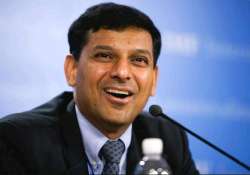'RBI could have leveraged abating inflation to cut rates'
New Delhi: Disappointed over the RBI's decision to keep interest rates unchanged, India Inc today said the central bank could have leveraged abating inflation risks to effect a rate cut, as high cost of credit

New Delhi: Disappointed over the RBI's decision to keep interest rates unchanged, India Inc today said the central bank could have leveraged abating inflation risks to effect a rate cut, as high cost of credit has been dissuading industry from undertaking capacity expansion.
“At a time when industrial growth continues to be sluggish, CPI-based inflation is moderating and above all, inflation risk is gradually abating due to an improvement in monsoon conditions, the RBI could have taken this opportunity to effect a cut in interest rates,” said CII Director-General Chandrajit Banerjee.
“The high cost of capital has been dissuading industry from undertaking capacity expansion and is causing financial stress among firms where demand is credit-driven,” he added.
“The retention of the benchmark lending rate, repo, at eight per cent, is a clear indication of RBI's pronounced bias in favour of further cutting inflation, which may not help revive growth to the extent of its potential of six per cent in the current fiscal,” Assocham President Rana Kapoor said.
However, industry bodies — FICCI, CII and PHD — have welcomed the RBI's decision to lower banks' minimum bond holding requirements, known as SLR, by 50 basis points, saying the move will help augment liquidity in the system and channelise fund flows to productive sectors of the economy, even as Assocham termed it a “symbolic move”.
Concerned over the impact of a weak monsoon on food prices, RBI decided to keep the key policy rate unchanged but slashed the statutory liquidity ratio (SLR) by 0.5 per cent to unlock about Rs. 40,000 crore into the system.
RBI Governor Raghuram Rajan, who has for the third time in a row kept the rate unchanged, said there are upside risks to inflation in view of an uncertain monsoon and its impact on food production as also volatile international oil prices.
“Steps taken by the Government to manage food inflation should be followed up with close coordination with the States to ensure that the mitigating impact of the same is seen at the earliest,” FICCI President Sidharth Birla said.
Accordingly, the repo rate will continue to stand at 8 per cent, the reverse repo at 7 per cent and the cash reserve ratio at 4 per cent. The Bank Rate would remain at 9 per cent.
“We believe reduction in the repo rate would be critical to revive industry sector growth and to refuel the growth trajectory in the coming times,” PHD Chamber President Sharad Jaipuria said.
“The high rate of interest, without adequate interest subsidy, would be a dampener for the optimism being witnessed in some external markets, particularly the US,” exporters' body EEPC India Chairman Anupam Shah said.
Inflation measured by consumer prices cooled to a 43-month low of 7.31 per cent for June, while the factory output came in at 4.7 per cent in May, the highest in the last nine months.
“At a time when industrial growth continues to be sluggish, CPI-based inflation is moderating and above all, inflation risk is gradually abating due to an improvement in monsoon conditions, the RBI could have taken this opportunity to effect a cut in interest rates,” said CII Director-General Chandrajit Banerjee.
“The high cost of capital has been dissuading industry from undertaking capacity expansion and is causing financial stress among firms where demand is credit-driven,” he added.
“The retention of the benchmark lending rate, repo, at eight per cent, is a clear indication of RBI's pronounced bias in favour of further cutting inflation, which may not help revive growth to the extent of its potential of six per cent in the current fiscal,” Assocham President Rana Kapoor said.
However, industry bodies — FICCI, CII and PHD — have welcomed the RBI's decision to lower banks' minimum bond holding requirements, known as SLR, by 50 basis points, saying the move will help augment liquidity in the system and channelise fund flows to productive sectors of the economy, even as Assocham termed it a “symbolic move”.
Concerned over the impact of a weak monsoon on food prices, RBI decided to keep the key policy rate unchanged but slashed the statutory liquidity ratio (SLR) by 0.5 per cent to unlock about Rs. 40,000 crore into the system.
RBI Governor Raghuram Rajan, who has for the third time in a row kept the rate unchanged, said there are upside risks to inflation in view of an uncertain monsoon and its impact on food production as also volatile international oil prices.
“Steps taken by the Government to manage food inflation should be followed up with close coordination with the States to ensure that the mitigating impact of the same is seen at the earliest,” FICCI President Sidharth Birla said.
Accordingly, the repo rate will continue to stand at 8 per cent, the reverse repo at 7 per cent and the cash reserve ratio at 4 per cent. The Bank Rate would remain at 9 per cent.
“We believe reduction in the repo rate would be critical to revive industry sector growth and to refuel the growth trajectory in the coming times,” PHD Chamber President Sharad Jaipuria said.
“The high rate of interest, without adequate interest subsidy, would be a dampener for the optimism being witnessed in some external markets, particularly the US,” exporters' body EEPC India Chairman Anupam Shah said.
Inflation measured by consumer prices cooled to a 43-month low of 7.31 per cent for June, while the factory output came in at 4.7 per cent in May, the highest in the last nine months.